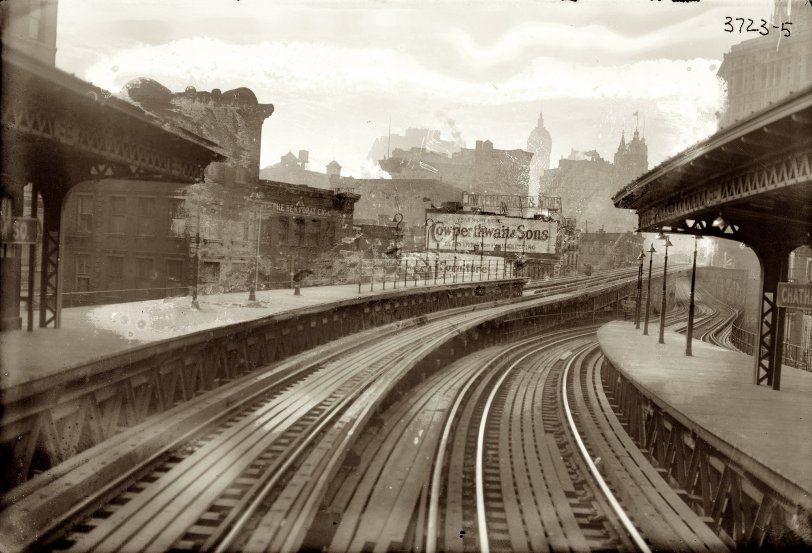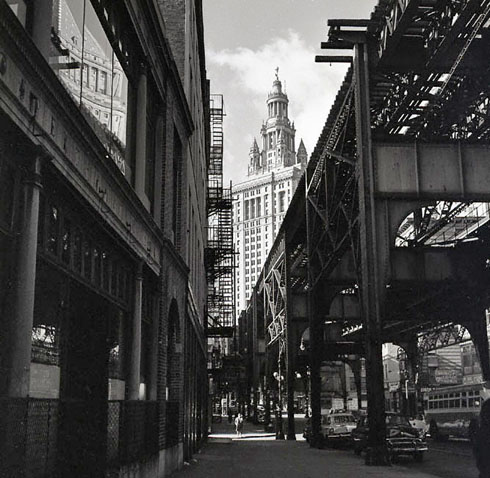


Framed or unframed, desk size to sofa size, printed by us in Arizona and Alabama since 2007. Explore now.
Shorpy is funded by you. Patreon contributors get an ad-free experience.
Learn more.

- Lofty addition
- In 1912
- Keenan Building
- Six years old
- Taken from the P.J. McArdle Roadway?
- It stood only 47 years
- Three track mind
- Incline to the right
- Reach for the sky, 1912 style
- No clean sweep
- Same Job Title, Same Face
- Sadly Lost
- Beautiful ...
- Where you get your kicks
- Aim High
- Pueblo Revival sisters
- Pueblo Neoclassicism
- Milk Man
- Regional dialect.
- Spielberg's inspiration
- Great Photo
- Loaf Story
- Do you still have the Rakes category?
- Could almost be a scene from the 1957 movie 'Hell Drivers'
- The Wages of Fear.
- Conspicuous by their absence
- Got Milk?
- All that aluminum
- No lefties
- Smoke 'em if you've got 'em
Print Emporium
Third Avenue El: 1910

New York circa 1910. "Looking toward City Hall. Third Avenue 'L.' " 5x7 glass negative, George Grantham Bain Collection. View full size.
3rd Ave. El Chatham Sq Station
My father worked as a station agent and station master at this Chatham Square station, among many others on the four Manhattan El Lines. The fare control area at that station was in a large mezzanine under the platforms and tracks. There were two Chatham Square stations. I rode 3rd Ave El trains to and thru both of them many times in the 1950s. The photo shows the 4 track, 2 island platform City Hall branch line Chatham Square station.
The left (south) portion 2 tracks and one platform were for 2nd Ave El trains, that El which closed and trains stopped running in June 1942, and that side remained abandoned but still intact thru late 1953 as it was structurally attached to the 3rd Ave. operated side. The right (north) portion 2 tracks and one platform were used by 3rd Ave El Trains up until the City Hall branch was closed in late 1953. The entire huge station complex was torn down thru to the City Hall Terminal station a few blocks S.W. along Park Row.
The other adjacent Chatham Square station was a double-decked structure over St. James St. The lower level was for 2nd Ave El trains to South Ferry and the lower level station and track ways were abandoned in mid-June 1942 with the closing of the 2nd Ave El. The upper level was for 3rd Ave El trains to South Ferry and was used as a thru station until the South Ferry branch line closed in November 1950, and structure removed in 1951 just below that double-decked Chatham Square Station.
The upper level 2 tracks and single island platform became a secondary, and a terminal, station at Chatham Square in addition to the adjacent Chatham Square station for the City Hall branch. After the City Hall branch closed in late 1953, the former South Ferry line Chatham Square upper level station, 4 stories above the street, became the new and only remaining southern terminal for all 3rd Avenue El trains, until that El closed for good after 7PM, Thursday, May 12, 1955. All 3rd Ave El structures in Manhattan were removed by February 1956.
Back Track
Thanks to TJ Connick for all that information about Cowperthwaite and the elevated line to the Brooklyn Bridge, it's much appreciated.
Living in New York, I often wish I could jump back in time, where one of the things I would surely want to do is ride some of the Manhattan elevated lines. As you know I'm sure, we still have them in Queens and Brooklyn, a few, but as far as I know, none in Manhattan (perhaps way uptown, I'm not sure about that).
Tarrying in Mulberry Shade
... beneath the disused City Hall spur shared by the 2nd and 3rd Avenue elevated lines. By the time of Frank Larson's shot, the branch was out of commission and being dismantled. He took this shot directly in front of what had been Cowperthwait's, where Mulberry joined Park Row. In the window of the first building, the fractured reflection of Cass Gilbert's 40 Centre Street is cleverly captured. The four-story second building was also part of the store, sitting at the widely advertised 193-205 Park Row location. The fire escape hangs upon a taller third building, 191 Park Row. Although it sported the big sign, it was not part of the store.
What follows is slanted to rail heads, but helps to confirm Larson's position.
The Bain shot shows a section of Chatham Square station serving exclusively the City Hall spur. The four-track, two-platform section was part of an extensive set of elevated-line service improvements that went into effect in early 1916. Untangling an awkward junction, enabling 2nd Avenue el trains for the first time to serve City Hall station, and eliminating the infamous bridge that had been used by transferring passengers -- the Chatham Square work was a major reconfiguration.
On the left platform in the photo were the 2nd Avenue trains - uptown on the outside, downtown on the inside - serving the remodeled City Hall station on its upper level. Third avenue trains ran on the lower level using the platform on the right; uptown on the inside, downtown on the outside. Bain's photo captured but a portion of the station, and although it may look like it dates from the Pierce administration, showed things as they would not have looked before late 1915.
Note track workers on the outside 2nd Avenue tracks, occupied near a signal. The signal is the precursor of a more elaborate one whose platform's skeletal remains protrude from the partially dismantled el in Larson's shot.
Cowperthwaite Update
I know this is really late to the game, but if you look at this map, and zoom into the top right end of Park Row, you'll see Cowperthwaite and Sons owned a few buildings.
All of these building on both sides have been demolished, to make room for Federal court, Manhattan correctional facility and Police Plaza. Also ramps off the Brooklyn bridge.
While it doesn't show the Cowperthwaite building exactly, my grandfather took a pretty nice picture of Park Row on a location that would have been just about in front of the store, give or take a block or two.

Cowperthwait & Sons
I just found a six inch ruler that was used by Cowperthwait & Sons as a means of advertisement. It lists the addresses of all three stores on front and lists what they sell on the back with a line about installment payments. I am interested to learn more about this store and when they ceased operating.
"L" train
this has got to be one of my all-time favorite photos. So beautiful! The damage to the negative actually adds to its impressionistic quality.
Domed building
The dome with the flag was the New York World Building, yet another one of those structures that were once the tallest in the world. It was torn down in the mid-1950s and Pace University now occupies part of the site. I will have to walk through the area - now largely occupied by government buildings - to see whether any of the foreground buildings remain standing.
Cowperthwait Today
The row of buildings including Cowperthwait and the cigar company may be on Park Row. In which case, I would guess about half of them still remain, mostly housing various branches of the J&R electronics empire (JandR.com).
The Cowperthwait building in Harlem has been demolished and is currently an empty lot awaiting the official rezoning of 125th street before it can be developed. The planned building would be 630,000 square feet, and Major League Baseball would be the anchor tenant.
Cowperthwait & Sons, since 1807
Cowperthwait & Sons was founded in 1807 and grew along with New York City "to supply household requisites to all classes of homes as they multiplied over and over." It was one of the earliest stores to actively cater to and serve the black population in NY from its Harlem store on 125th St. In 1907 they published the Cowperthwait Centennial March, with words and music by Abe Holzmann for their 100th anniversary 1807 to 1907.
So this might be in 1913.
Chatham Square, 3rd Avenue El
1950s views from the El at Chatham Square.
In 1878, a ride on the El.
Third Avenue El Video
This was very well done. Occasionally I would take the Third Avenue El from the 169th Street Station, in the Bronx, to City College on 23rd Street. I remember the RR tracks overhanging the sidewalk in some places only 2 or 3 feet from the buildings on Third avenue. You could get a glimpse of the old tenements that housed working families, and the noise from the trains was deafening. The El in Manhattan came down in the early 1950s and Third Avenue became a business center with highrise office and residential buildings. Many of the original tenement structures, built in the late 19th and early 20th centuries, still survive, and the apartments that are no longer rent-controlled command outrageous prices but have no problem attracting tenants.
Third Avenue El
If you're interested in the Third Avenue El, check out this vid:
Chatham Square
This was the Chatham Square stop. In 1910 that was quite a seedy part of Manhattan.
Easy Payments
Cowperthwait & Sons pioneered installment credit at their Third Avenue store at about the time this picture was taken. They sold Singer sewing machines to their most reliable customers for scheduled payments. This was the forerunner of credit cards. Previously if a store allowed charge accounts, the entire balance had to be paid in 30 days.
Third Avenue
I used to work near here. The municipal building visible in the upper right still exists. I have been inside only once, when my wife and I were getting our marriage license.
The domed building to the left, also extant, sits behind City Hall. I am pretty sure that the eastern wing of City Hall is the rectangular building visible between the cigar company and Cowperthwaite, to the left.
The tallest building in haze in the back is, of course, the Singer Building. That's one of the most famous architectural silhouettes of all time, even though the building was torn down in the 1960s.
Longevity
Cowperthwait & Sons in business since 1804. Wow.
Otherworldly
The large view is quite rewarding. Quite otherworldly. Interesting sign claims a business is in its 106th year at same location.
























On Shorpy:
Today’s Top 5